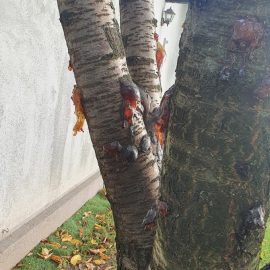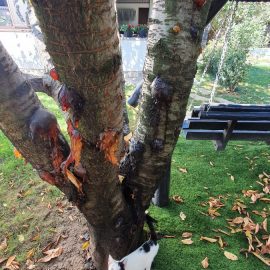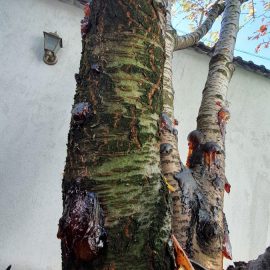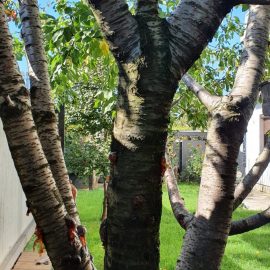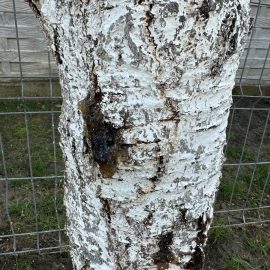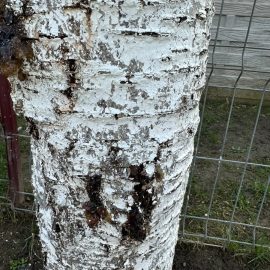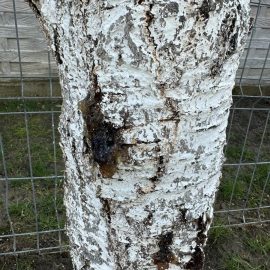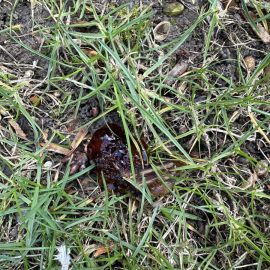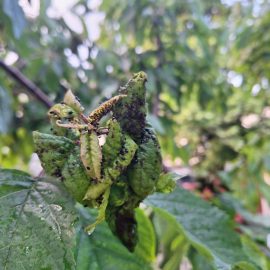Cherry tree, planting, growing and harvesting
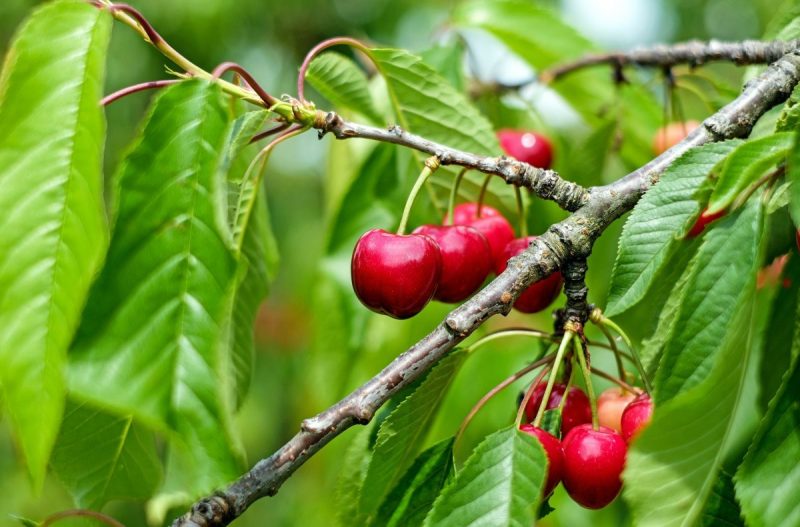
Cherry tree (Prunus avium) has been cultivated since ancient times, due to its delicious fruits. Cherries are the first fresh fruit to appear in spring. The tree develops a strong root, the stem is straight, with a smooth bark that exfoliates. The leaves are large, rough, and with serrated edges. The flowers are white, long peduncled. Fruits have a high nutritional value. These contain water, vitamins (A, C, B complex), iron, magnesium, potassium, zinc, and sugars. Cherry stems have therapeutic properties.
Growing and fruiting peculiarities
Root growth is influenced by soil properties. The aerial part grows slowly in the first years after planting. It naturally forms airy and well-lit crowns. Flowering buds form inflorescences containing 2-4 flowers. Flowering takes place after about 15 days with temperatures above 8 °C. Cherry pollination is self-sterile entomophilic. For pollination to take place normally, it is necessary to plant several varieties in the orchard. For a good harvest, 30% of the number of flowers on the tree must be pollinated. The cherry produces the first fruits after 3-4 years, and after 5-6 years it reaches the production potential. A cherry orchard can bear fruits for 30-40 years.
Climate and soil requirements
The cherry tree is a heat-loving tree. It grows well in the area of small and medium hills. It has a deep dormancy and is not affected (very rarely) by late frosts. In the flower’s opening phase, the cherry withstands temperatures of -2 °C. The cherry grows well in areas where 600-700 mm of rainfall falls yearly. The stagnant water in the soil causes the roots to suffocate. Excessive moisture during the ripening phase causes fruit cracking. It is a light-loving species. It is recommended to plant on slopes with southern exposure. The fruits are low-quality on shady lands, and the branches peel off quickly. Prefers deep, permeable soils with a light texture. It does not tolerate heavy, moist, and cold soils.
Soil preparation
The land must be chosen carefully because the cherry does not tolerate stagnant water. The plot on which the orchard will be established must have a south or south-east exposure and the rows of trees must be oriented north-south, thus ensuring a large amount of light throughout the day. The land should be worked according to the general rules. If the plantation is set up on land that has been used as an orchard, the land should be prepared 1-2 years in advance. To restore the soil structure and eliminate outbreaks of infection, the land can be cultivated with perennial grasses. If the ground is heavily infested with weeds, you can apply a non-selective herbicide.
Recommended products
-
You can find products on a different store
Change Store -
You can find products on a different store
Change Store -
You can find products on a different store
Change Store -
You can find products on a different store
Change Store -
You can find products on a different store
Change Store -
You can find products on a different store
Change Store -
You can find products on a different store
Change Store -
You can find products on a different store
Change Store -
You can find products on a different store
Change Store -
You can find products on a different store
Change Store -
You can find products on a different store
Change Store -
You can find products on a different store
Change Store -
You can find products on a different store
Change Store -
You can find products on a different store
Change Store -
You can find products on a different store
Change Store -
You can find products on a different store
Change Store -
You can find products on a different store
Change Store -
You can find products on a different store
Change Store -
You can find products on a different store
Change Store -
You can find products on a different store
Change Store -
You can find products on a different store
Change Store -
You can find products on a different store
Change Store -
You can find products on a different store
Change Store -
You can find products on a different store
Change Store
The soil should be fertilized with organic fertilizers (manure, compost). It is recommended to scarify the soil so that the roots grow easily. All foreign matter in the soil must be collected and removed from the plot, after which the soil must be well-leveled.
For precise planting, the land can be picketed.
Picketing is the process of marking the position of each cherry tree on the ground. Specifically, a stake is inserted into the tree planting site. Cherry trees should not planted after cherry, nectarine, peach, plum, or other stone fruit trees (after 5 years).
Planting
The best time to plant is autumn because the cherry tree can start growing more easily in spring. To ensure pollination, plant at least three different varieties in alternating rows. In the classic system, two planting schemes can be implemented: 5 meters distance between rows and 4 meters distance between trees per row or 6 meters distance between rows and 5 meters distance between trees per row (for varieties with high vigor). In the case of intensive crops, depending on the vigor of the trees, the approximate planting distances are 4 meters between rows and 2-3 meters between trees per row. The cherry trees should be purchased from authorized nurseries or orchards.
Before planting, the saplings must be prepared for the new conditions in the orchard.
To stimulate root development, the roots should be trimmed. This operation is performed to remove the damaged portions and to maintain a healthy root system. The necrotic roots must be completely removed, and the healthy ones, shortened by 7-8 cm.
Trimming must be done only if the cherry saplings have been recently removed from the ground.
After trimming, the roots must be soaked. Mudding means dipping the root into a mixture of yellow soil, fresh manure, and water. The mud layer helps the tree to adapt to the new soil conditions and maintains the moisture around the roots.
Actual planting
This stage begins by digging the pit. If the land has not been worked, the pit must be dug 2-3 months before and have the following dimensions: 100 x 100 x 80 cm. If the land has been worked properly, the pit must be dug 1-2 days before or even on the same day. In this case, the pit will have the following dimensions: 50 x 50 x 50 cm.
The soil removed from the topside of the pit is mixed with well-decomposed manure and placed at the base of the pit. Insert the cherry sapling into the pit so that the root stays on the fertile layer at the base. When planting, the roots must be in close contact with the soil. The grafting point should be 3 cm above the ground and facing north. If the grafting point is covered with earth, the graft will emit its roots. After planting, the soil should be well watered, and a stake should be placed next to the saplings to support them.
Care works
In spring, it is recommended to ensure the necessary water supply and to keep the orchard clean. The soil around the trees must be dug up and covered with straw manure. Besides conserving water, the mulch increases microbial activity around the roots. In the spring, the protective material around the trees should be removed and the necessary water should be provided. In the case of young cherry orchards, irrigation is mandatory. The soil around the trees has to be lightly dug and covered with plant debris (mulch). Mulching maintains a good phytosanitary condition, prevents weed growth, conserves water in the soil, and reduces the number of maintenance works. The spacing between trees must be kept clean because weeds consume water and nutrients needed by the trees. During the first three years of growth, do not use herbicides.
Prunings
Cherry trees require pruning every year. This ensures constant yields and the longest possible plantation life. In the first spring after planting, all twigs should be shortened to 60-90 cm above ground level. In autumn, choose 3 twigs evenly placed on the tree, which will form the skeleton of the future crown, and remove the rest of the growth. The main axis twig should be cut above an outward-facing shoot.
In the second year after planting, the 3 chosen twigs must be shortened to a height of 1.2 m above ground level. All water sprouts and lush vegetative growths must be eliminated.
In the third year, choose an extension branch for the three chosen twigs. They must be facing outwards and shortened to a length of 60 cm. All water sprouts competing with the main branches should be removed. If the annual branches do not exceed 80 cm in length, they should not be shortened. The annual branches will be shortened (if necessary) to normalize production. Wounds larger than 2 cm in diameter must be covered with pruning sealer.
Recommended products
-
You can find products on a different store
Change Store -
You can find products on a different store
Change Store -
You can find products on a different store
Change Store -
You can find products on a different store
Change Store -
You can find products on a different store
Change Store -
You can find products on a different store
Change Store -
You can find products on a different store
Change Store -
You can find products on a different store
Change Store -
You can find products on a different store
Change Store -
You can find products on a different store
Change Store -
You can find products on a different store
Change Store -
You can find products on a different store
Change Store -
You can find products on a different store
Change Store -
You can find products on a different store
Change Store -
You can find products on a different store
Change Store -
You can find products on a different store
Change Store -
You can find products on a different store
Change Store -
You can find products on a different store
Change Store -
You can find products on a different store
Change Store -
You can find products on a different store
Change Store -
You can find products on a different store
Change Store -
You can find products on a different store
Change Store -
You can find products on a different store
Change Store -
You can find products on a different store
Change Store
The cherry tree tolerates well prunings during the vegetation.
In June, 20-30 cm long twigs should be pinched off. This operation stimulates fruit bud development and reduces the cherry tree’s vigor. After this operation, the water sprouts must be removed. In August (after harvest) pruning can be carried out according to the basic principles. These prunings can replace prunings during the dormant period.
After crown growth (1-4 years) pruning should be reduced. In the following years (5-10) the tree maintains its shape and fruiting capacity. During this period, pruning consists of removing water sprouts, limiting the height, and eliminating branches that intersect. After 9-10 years of fruiting, the tree needs severe pruning to regenerate. Gradually remove 5-6-year-old branches to stimulate the development of new branches.
Recommended products
-
You can find products on a different store
Change Store -
You can find products on a different store
Change Store -
You can find products on a different store
Change Store -
You can find products on a different store
Change Store -
You can find products on a different store
Change Store -
You can find products on a different store
Change Store -
You can find products on a different store
Change Store -
You can find products on a different store
Change Store -
You can find products on a different store
Change Store -
You can find products on a different store
Change Store -
You can find products on a different store
Change Store -
You can find products on a different store
Change Store -
You can find products on a different store
Change Store -
You can find products on a different store
Change Store -
You can find products on a different store
Change Store -
You can find products on a different store
Change Store -
You can find products on a different store
Change Store -
You can find products on a different store
Change Store -
You can find products on a different store
Change Store -
You can find products on a different store
Change Store -
You can find products on a different store
Change Store -
You can find products on a different store
Change Store -
You can find products on a different store
Change Store -
You can find products on a different store
Change Store
Fruiting stimulation
These operations stimulate the tree to produce more fruits, to bear fruit faster, or to develop stronger twigs:
- Branch training: represents the change of natural position of the branches, towards the vertical. This causes the branch to grow and strengthen. This operation should carried out mainly in the mature phase of the trees. In this phase, the vegetative growth ceases and this operation leads to the rejuvenation of the tree crown.
- Branch tying down: it consists in changing the position of the branches, towards the horizontal. This causes the fruit buds on the branch to grow and aerates the crown. Branches can be tied down below the horizontal to obtain abundant fruiting. This operation is practiced in the young stage of the trees when vegetative growth is predominant.
- Branch arching: through this change of position, the basal part remains ascending, and the terminal part is inclined below the horizontal (descent). This operation stops or slows down the growth in length of the branch and promotes bud growth. Trees that have been arched begin to bear fruit 2-3 years earlier.
- Transverse incision: represents the disruption of the vessels by a fine cut with a sharp blade. The cut must be made above a bud.
- Longitudinal incision: represents a fine cut along the length of the trunk. This operation helps to increase the thickness of the trunk.
- Twisting: consists of twisting a branch or twig. This operation stimulates fruiting.
- Branch breaking: it is practiced in the case of branches that have an inappropriate orientation. Fruiting occurs quickly on broken branches.
Weed control
The interval between rows must be kept clean. Weeds can be cut with a weed cutter to add organic matter to the soil or removed chemically. Spraying should be done with approved products, carefully so that the spray does not get on the cherry leaves. During the first three years after planting do not use herbicides.
Recommended products
-
You can find products on a different store
Change Store -
You can find products on a different store
Change Store -
You can find products on a different store
Change Store -
You can find products on a different store
Change Store -
You can find products on a different store
Change Store -
You can find products on a different store
Change Store -
You can find products on a different store
Change Store -
You can find products on a different store
Change Store -
You can find products on a different store
Change Store -
You can find products on a different store
Change Store -
You can find products on a different store
Change Store -
You can find products on a different store
Change Store -
You can find products on a different store
Change Store -
You can find products on a different store
Change Store -
You can find products on a different store
Change Store -
You can find products on a different store
Change Store -
You can find products on a different store
Change Store -
You can find products on a different store
Change Store -
You can find products on a different store
Change Store -
You can find products on a different store
Change Store -
You can find products on a different store
Change Store -
You can find products on a different store
Change Store -
You can find products on a different store
Change Store -
You can find products on a different store
Change Store
Irrigation
Given that the cherry tree is a species sensitive to excessive soil moisture, irrigation should be carried out so that the water does not stagnate and is in correlation with the soil moisture at that time. Recommended irrigation methods are drip irrigation and micro-sprinkler irrigation (under the tree’s crown).
Protecting trees from frost
When low temperatures are announced, in the orchard, you can burn easily burning materials (gathered in piles), which produces a large amount of smoke (rubber, straw, manure, tar, peat, etc.). Thus, the smoke layer that forms above the orchard does not allow heat to be released from the soil and thus maintains a higher temperature at the trunk/tree crown level. It is important to keep the fire on throughout the night, especially before sunrise, when temperatures drop sharply. This operation can protect the trees from temperatures down to -3 °C.
Fertilization
Fertilizer application (dosage, ratio of elements) should be done only after a chemical soil analysis. Cherry tree reacts well to both granular and foliar fertilizers.
Recommended products
-
You can find products on a different store
Change Store -
You can find products on a different store
Change Store -
You can find products on a different store
Change Store -
You can find products on a different store
Change Store -
You can find products on a different store
Change Store -
You can find products on a different store
Change Store -
You can find products on a different store
Change Store -
You can find products on a different store
Change Store -
You can find products on a different store
Change Store -
You can find products on a different store
Change Store -
You can find products on a different store
Change Store -
You can find products on a different store
Change Store -
You can find products on a different store
Change Store -
You can find products on a different store
Change Store -
You can find products on a different store
Change Store -
You can find products on a different store
Change Store -
You can find products on a different store
Change Store -
You can find products on a different store
Change Store -
You can find products on a different store
Change Store -
You can find products on a different store
Change Store -
You can find products on a different store
Change Store -
You can find products on a different store
Change Store -
You can find products on a different store
Change Store -
You can find products on a different store
Change Store
Pests and disease control
The plantation’s phytosanitary condition is very important. Carrying out phytosanitary treatments according to a specific schedule can significantly reduce the occurrence of diseases and pests.
To destroy outbreaks of infection in the orchard, apply treatments during the dormant period (winter). Treatments should be applied in winter windows when the temperature is above 5 °C.
Against diseases, the first treatment (after leaf fall) should be done with copper-based products. The second spraying with copper-based products must be done in spring, at bud break. The solution should be sprayed all over the tree, from the base of the tree to the branches. These treatments need to be applied on days without rainfall, with temperatures above 6-7° C, so the solution does not freeze on the trees. 7-10 days after applying the copper treatments, apply a horticultural oil treatment, which acts against pests that may overwinter in the bark of the tree.
Recommended products
-
You can find products on a different store
Change Store -
You can find products on a different store
Change Store -
You can find products on a different store
Change Store -
You can find products on a different store
Change Store -
You can find products on a different store
Change Store -
You can find products on a different store
Change Store -
You can find products on a different store
Change Store -
You can find products on a different store
Change Store -
You can find products on a different store
Change Store -
You can find products on a different store
Change Store -
You can find products on a different store
Change Store -
You can find products on a different store
Change Store -
You can find products on a different store
Change Store -
You can find products on a different store
Change Store -
You can find products on a different store
Change Store -
You can find products on a different store
Change Store -
You can find products on a different store
Change Store -
You can find products on a different store
Change Store -
You can find products on a different store
Change Store -
You can find products on a different store
Change Store -
You can find products on a different store
Change Store -
You can find products on a different store
Change Store -
You can find products on a different store
Change Store -
You can find products on a different store
Change Store
Recommended products
-
You can find products on a different store
Change Store -
You can find products on a different store
Change Store -
You can find products on a different store
Change Store -
You can find products on a different store
Change Store -
You can find products on a different store
Change Store -
You can find products on a different store
Change Store -
You can find products on a different store
Change Store -
You can find products on a different store
Change Store -
You can find products on a different store
Change Store -
You can find products on a different store
Change Store -
You can find products on a different store
Change Store -
You can find products on a different store
Change Store -
You can find products on a different store
Change Store -
You can find products on a different store
Change Store -
You can find products on a different store
Change Store -
You can find products on a different store
Change Store -
You can find products on a different store
Change Store -
You can find products on a different store
Change Store -
You can find products on a different store
Change Store -
You can find products on a different store
Change Store -
You can find products on a different store
Change Store -
You can find products on a different store
Change Store -
You can find products on a different store
Change Store -
You can find products on a different store
Change Store
Harvesting
Cherry fruits should be harvested when fully ripe. The optimum time for harvesting depends on the size and fruit color, firmness of the flesh, sugar content, etc. If harvesting is not done in time, the fruit will rot on the tree. The cherries can be harvested by hand. The fruit must be kept in cold storage and washed only before consumption.




















































































































































































































































































































































































































































